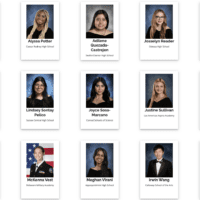The Wilmington Learning Collaborative says it needs three extra months to set performance requirements for the schools it’s overseeing.
That means the organization will have to go back to the Brandywine, Christina and Red Clay districts for permission to move the deadline from March 31 to June 30.
The performance requirements include setting goals through written agreements with the three districts to ensure the collaborative is accountable to each district for improving student outcomes.
Councilwoman Shanika Dickerson, who’s also a Brandywine school board member, pointed out that she didn’t think the council could make its agreement deadlines before an upcoming WLC retreat.
Because any change requires an adjustment to the memorandum of understanding that authorizes the collaborative, the council’s legal counsel and all three school boards have to approve the change.
The collaborative was created in November 2022 . Its goal is to improve social and academic outcomes for students at nine Wilmington elementary schools through creative programming and student services that involve parents and educators
Council member Dan Shelton, superintendent of Christina, reminded his peers that each district agenda must be updated, and they will have to vote on it in their March meeting in order to have an answer by the March 31 deadline.
Christina’s March school board meeting is on Tuesday, March 12; Red Clay’s is on Wednesday, March 20; and Brandywine’s is on Monday, March 18.
Laura Burgos, the collaborative’s executive director, said June 30 would be enough time, and pointed out that the group will have received its opportunity scorecard reports by then.
“This is the first wave of individual school reports,” Burgos said. “Keep in mind that these will go directly to our school and district leaders and these will be used as learning tools. I will not be sharing these publicly. These are reports that need to be internalized and discussed with our school-based teams.”
In part, the scorecards highlight promising practices that are already in place at schools that the collaborative can build upon and share across schools. They also include a set of recommendations by individual schools on how the collaborative could create programs to serve its unique needs.
Those are expected to be submitted in March.
Councilman Dorrell Green, superintendent of Red Clay, said the June 30 deadline for setting performance requirements also might be too early, since much of the state performance data isn’t released until August or September.
The collaborative should align performance goals with the state performance data in mind, he said.
“We know we’re not going to meet March 31, we just have to acknowledge that publicly, and I think that may have been an oversight on our part,” he said. “I think maybe just having the council provide something to our respective boards, that way we can have a first reading and first discussion, bring our school boards up to speed at the March meeting, and then look at a subsequent date after that.”
Councilman Lincoln Hohler, Brandywine’s superintendent, agreed that it’s important to wait for state data.
Shelton said the collaborative plan should match the state’s Comprehensive Support and Improvement and Targeted Support and Improvement plans.
RELATED: 53 schools on improvement plans to be re-evaluated next year
All nine WLC schools are on a state improvement plan, which looks at factors like the number of the school’s students who have disabilities, are impoverished, are homeless, are English language learners and more.
The state improvement plans conduct a needs assessment for struggling schools which helps determine where finances should be allocated.
After the meeting, Shelton said he would envision that the goals will be similar to current state improvement goals, which focus on student outcomes and ways that collaborative may reach its desired outcomes.
“Potentially there would also be goals around WLC specific objectives such as our Community Councils and Educator Leadership Teams, which are currently being stood up,” he said.
Several council members also took time to applaud Burgos for her presentation in the Joint Finance Committee last week, during which she requested about $16 million in state funding for fiscal year 2025, which is July 1 to June 30, 2025.
RELATED: Education groups costing ⅓ of state budget face JFC
This was Burgos’s first time in front of the JFC, and her fellow council members said she handled the “hot seat” with tenacity, bravery and composure.
Latest news on WLC
Jan. 31: WLC building 9 community councils, strengthening partnerships
Dec. 21, 2023: WLC leader details initial work, school reports
Dec. 20, 2023: WLC hires 2, completes school assessments
Dec. 15, 2023: Redding Consortium, WLC define aligned goals
Nov. 29, 2023: WLC will focus on tasks at hand, not expanding to other schools
Oct. 18, 2023: How the WLC plans to spend $16.6M to improve city schools


Raised in Doylestown, Pennsylvania, Jarek earned a B.A. in journalism and a B.A. in political science from Temple University in 2021. After running CNN’s Michael Smerconish’s YouTube channel, Jarek became a reporter for the Bucks County Herald before joining Delaware LIVE News.
Jarek can be reached by email at [email protected] or by phone at (215) 450-9982. Follow him on Twitter @jarekrutz and on LinkedIn
Share this Post









